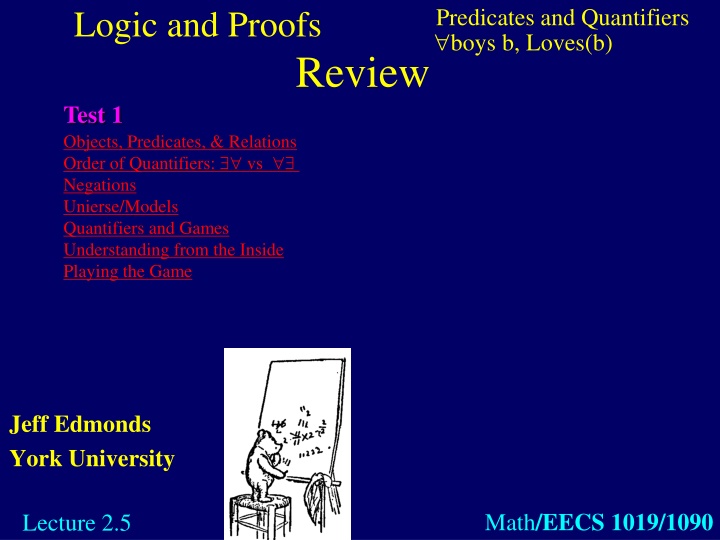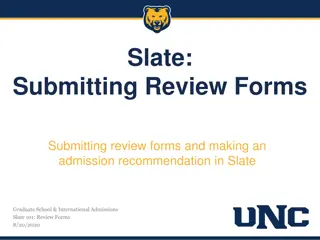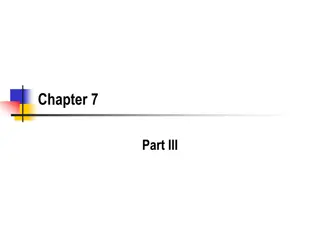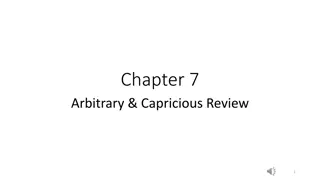
Understanding Predicates and Quantifiers in Logic
This content delves into the concepts of predicates and quantifiers in logic, covering topics such as objects, relations, order of quantifiers, negations, and understanding the difference between 'for all' and 'exists'. It also discusses the use of predicates to define properties and relations among objects, as well as providing examples and tips for problem-solving in logic and proofs.
Uploaded on | 0 Views
Download Presentation

Please find below an Image/Link to download the presentation.
The content on the website is provided AS IS for your information and personal use only. It may not be sold, licensed, or shared on other websites without obtaining consent from the author. If you encounter any issues during the download, it is possible that the publisher has removed the file from their server.
You are allowed to download the files provided on this website for personal or commercial use, subject to the condition that they are used lawfully. All files are the property of their respective owners.
The content on the website is provided AS IS for your information and personal use only. It may not be sold, licensed, or shared on other websites without obtaining consent from the author.
E N D
Presentation Transcript
Predicates and Quantifiers boys b, Loves(b) Logic and Proofs Review Test 1 Objects, Predicates, & Relations Order of Quantifiers: vs Negations Unierse/Models Quantifiers and Games Understanding from the Inside Playing the Game Jeff Edmonds York University Math/EECS 1019/1090 Lecture 2.5
Oracle on Test 2 DO NOT DO PROBLEMS OF THE FORM: [ x A(x)] [ x A(x)] Note the top operation is . This requires a oracle which we have not done. It will not be on the test. DO NOT DO PROBLEMS OF THE FORM: [ x A(x)] OR [ x A(x)] Notice the top operation is OR. DO SOLVE x [ y A(x,y) or B(x,y)] because the TOP operation is forall x So you start by saying Let x be arbitrary (given by adversary).
Objects, Predicates, & Relations Predicates: boy(x), father(x), ... is True if and only if object x has stated property. Relations: loves(b,g), fatherOf(x,y), ... is True if and only if objects have stated relation. Defining: fatherOf(x,y) x is y s father . father(x) y fatherOf(x,y) daughter(y,x) iff father(x,y) girl(y) exist
Review Be sure to know what these mean and the difference between and is A for forAll is E for Exists 44
vs Sam There is a politician that is loved by everyone. Bob John Trudeau Fred politician, voters, Loves(v, p) voters, politician, Loves(v, p) Sam Scheer Bob Every voter loves some politician. John Trudeau Fred 5
vs x, y, y=f(x) This only says that f is a function that is defined on the whole domain. y, x, y=f(x) This also says that that f is the constant function. 6
vs I want you to feel physical pain Inputs x, Java Program J, J(x)=P(x) when you see But what you are saying is that each input value can have its own Java program! Problem P: Input: x Output: x2 Input: 1 2 3 4 Code: int J1( x ) return(1) int J2( x ) return(4) int J3( x ) return(9) int J4( x ) return(16) Instead Java Program J, Inputs x, J(x)=P(x) Input: Code: x int J( x ) return(x x) 7
Negations Loves(g) g, [Loves(g)] If there is not a g for which it is true, then for all g it is not true. [ ] g, Negations: A big Or A big And De Morgan's Law ( ) iff b, Loves(b) [ ] b, [ Loves(b) ] If it is not the case that it is true for all b, then there is a b for which it is not. [ ] Negations: Negations: g, b, Loves(b, g) g, [ b, Loves(b, g) ] g, b, [ Loves(b, g) ] 8
Negations [ ] g, b, Loves(b, g) g, [ b, Loves(b, g) ] g, b, [ Loves(b, g) ] Negations: Is this right? [ ] y x Loves(y) y>x Loves(y) y x Loves(y) Loves Loves Loves Loves y x Bring the negation in an switch and . We are still talking about values at most x. [ ] y Dogs Loves(y) y Cats Loves(y) y Dogs Loves(y) Cats ? Dogs Loves Loves Loves Loves Loves Loves Loves We are still talking about dogs 9
Universe/Model/Interpretation x, y, x+y=0 b, g, Loves(b,g) Whether the statement is true depends on the Universe. Sometimes I will assume the universe is the one provided in the question. What is the universe of objects for b and g? Who loves who? Over the Reals defines a set of objects to be U = reals. +, , , 0, 1, to be the standard. = is fixed by the logic to always mean the two objects are the same. = is fixed by the logic to always mean the two objects are the same. 10
Universe/Model/Interpretation U,Human,Mortal,Socrates, } Mortal(Socrates) A statement is Valid/Tautology if it is true in every Universe. Prove: M x, Human(x) Mortal(x) Human(Socrates) Whether the statement is true depends on the Universe. When proving this, I get to get to provide the worse case universe ie. set of objects U, predicates Human & Mortal, and fixed objects Socrates. 11
Quantifiers and Games If I assure you that b, Loves(b), then anyone can give me his favorite boy b and I assure him that Loves(b ) is true. Assuring Proving If I assure you that b, Loves(b), then I will provide my favorite boy b and I assure you that Loves(b ) is true. For me to prove b, Loves(b), then, the adversary gives me his favorite boy b and I must prove Loves(b ) is true. For me to prove b, Loves(b), then I will construct my favorite boy b and prove that Loves(b ) is true. 12
Quantifiers and Games AssuringProving In Predicate logic, we can state that I win the game: x, y, y>x all exist all exist I will prove x, [ y, y>x]. I choose a x = trillion trillion. exist I will prove y, y>x . I construct y = trillion trillion and one I will prove y >x . all exist The proof of x, y, y>x. Let x be an arbitrary integer. Let y = x +1 Note y = x +1 >x And this completes the proof. Surprisingly that completes the proof. 13
x, y, x+y=0 Prove: Sometimes I will assume the universe is the one provided in the question. Over the Reals defines a set of objects to be U = reals. +, , , 0, 1, to be the standard. = is fixed by the logic to always mean the two objects are the same. = is fixed by the logic to always mean the two objects are the same. 14
x, y, x+y=0 true Prove: Or condensed to x+y (x)=0 Build understanding by building the statement backwards. What does each subsequence say about ** value of free variables, * set of values of outer quantifier. 2 -2 y is the additive inverse of x . x has an additive inverse . Every real has an additive inverse . x+y=0 y, x+y=0 x, y, x+y=0 15
Playing the Game true (additive inverse) x, y, x+y=0 y, x, x+y=0 false (all additive inverses) y, x, x+y 0 true (not all additive inverses) Prove: true (additive zero) y, x, x+y=x Proof of x, y, x+y=0: 1. Let x be an arbitrary real number. 2. Let y = -x 3. The relation is true. x +y = x + (-x ) = 0 4. Prover can always win. Hence, the statement is true. 5. Every real number has an additive inverse. Note that the y can depend on everything that comes before it. 16
Playing the Game Hey Adversary, You can dictate your worst , Require it to be as small as you like. As long as I can counter with an even smaller . Or a really big n0. You are on. The heart of calculous is n0 17
Playing the Game Converge: We say that the sequence f = f(1), f(2), f(3), converges if ? c, if as i gets goes in the limit to infinity f(i) goes to some constant c. Prove that the sequence f = 1/1, 1/2, 1/3, 1/4, ie f(i) = 1/i converges. f(i) = 1/i ic=0 I am trying to prove that it does converge, so I get to chooses c. f(i) = 1/i seems to converge to c=0. 18
Playing the Game Converge: We say that the sequence f = f(1), f(2), f(3), converges if ? c, >0, n0, n n0,|f(n)-c| Prove that the sequence f = 1/1, 1/2, 1/3, 1/4, ie f(i) = 1/i converges. f(i) = 1/i ic=0 n n0 Goes to means that f(i) and c get very close. I get to decide how close I demand that they get. And they must be that close for every big n. I get to define the definition of big 19
Playing the Game Don t panic. Just play the game. Converge: We say that the sequence f = f(1), f(2), f(3), converges if ? c, >0, n0, n n0,|f(n)-c| Prove that the sequence f = 1/1, 1/2, 1/3, 1/4, ie f(i) = 1/i converges. f(i) = 1/i Let c = 0. Let >0 be arbitrary. Let n0 = Let n n0 be arbitrary. |f(n)-c| = |1/n -0| 1/n0 value here, but don t know how. Proof: ic=0 n n0 1/ n0( ) I am supposed to construct some Let s leave it for now. It is a function of . That was not so bad. 20
Playing the Game Converge: We say that the sequence f = f(1), f(2), f(3), converges if ? c, c. Prove that the sequence f = 1,-1,1,-1, ie f(i) = (-1)n converges. >0, n0, n n0,|f(n)-c| >0, n0, n n0, |f(n)-c|> 1 i -1 I, the prover, am asked to prove that it converges. But this sequence does not. It bounces back and forth between two different values. I will negate the statement and prove that. This reverses the roles between the prover and the adversary. 21
Playing the Game Converge: We say that the sequence f = f(1), f(2), f(3), converges if ? c, c. Prove that the sequence f = 1,-1,1,-1, ie f(i) = (-1)n converges. 1 -1 >0, n0, n n0,|f(n)-c| >0, n0, n n0, |f(n)-c|> c=1 =2 Now I, the adversary, am asked to prove that it converges. I will try. I start by stating the value c that I think it is converging to. How about c=1? But for all the odd n, f(n)=-1 |f(n)-c|=| (-1) (1) | = 2 = 22
Playing the Game Converge: We say that the sequence f = f(1), f(2), f(3), converges if ? c, c. Prove that the sequence f = 1,-1,1,-1, ie f(i) = (-1)n converges. 1 -1 >0, n0, n n0,|f(n)-c| >0, n0, n n0, |f(n)-c|> c=0 =1 Now I, the adversary, am asked to prove that it converges. I will try. I start by stating the value c that I think it is converging to. How about c=0? But none of f(n)=1 or -1 are close to 0. |f(n)-c|=| ( 1) (0) | = 1 = 23
Playing the Game Converge: We say that the sequence f = f(1), f(2), f(3), converges if ? c, c. Prove that the sequence f = 1,-1,1,-1, ie f(i) = (-1)n converges. 1 -1 >0, n0, n n0,|f(n)-c| >0, n0, n n0, |f(n)-c|> =11/2 c=-1/2 Now I, the adversary, am asked to prove that it converges. I will try. I start by stating the value c that I think it is converging to. How about c=-1/2? But for all the even n, f(n)=1 |f(n)-c|=| (1) (-1/2) | = 11/2 = 24
Playing the Game Don t panic. Just play the game. Converge: We say that the sequence f = f(1), f(2), f(3), converges if ? c, c. Prove that the sequence f = 1,-1,1,-1, ie f(i) = (-1)n converges. 1 -1 Let c be arbitrary. Let s have two cases: c 0 negative and c>0 positive. Let s do the c 0 case and by symmetry skip the c>0 case. Let = 1/3. ( =1 might have been fine) Let n0 be arbitrary. Let n n0 be an even integer so that f(n)=1. |f(n)-c|=| (1) (neg) | > 1/3 = >0, n0, n n0,|f(n)-c| >0, n0, n n0, |f(n)-c|> > =1/3 c=neg Proof: Was that too hard? 25
Playing the Game Continuous: Consider the function f(x) = x2 Prove: x, >0, >0, x' [x ,x+ ], |f(x')-f(x)| Let x>0 be arbitrary. Let >0 be arbitrary. Let = Let x' x+ be arbitrary. |f(x')-f(x)| = |(x') 2 - x2| |(x+ ) 2 - x2| = |2x + 2| = | (2x+ )| = We are supposed to construct some value here, but don t know how. Let s leave it for now, while remembering that it is a function of x and . / (2x+ ). ( ) Odd to have on both sides, Don t panic. but one could figure out . To prove, just play the game. f(x) f x . x 26
Playing the Game Continuous: Consider the function below. Prove: x, >0, >0, x' [x ,x+ ], |f(x')-f(x)| neg: x, >0, >0, x' [x ,x+ ], |f(x')-f(x)|> Let x=5. Let =0.0001. Let be arbitrary. It could be .000000000000000000000001 Let x' = x+ = 5+ [x ,x+ |f(x')-f(x)| = |f(5+ ) f(5)| |3.0002-3| = 0.0002 > 0.0001 = f(5.1) = 3.0002 f f(5) = 3 x=5 27






















